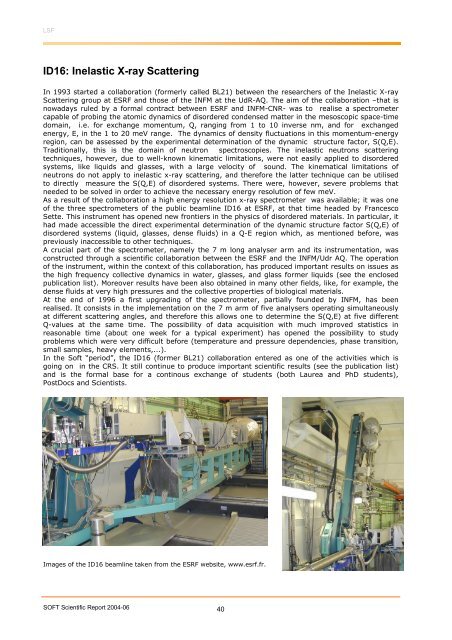Soft Report - Dipartimento di Fisica - Sapienza
Soft Report - Dipartimento di Fisica - Sapienza
Soft Report - Dipartimento di Fisica - Sapienza
Create successful ePaper yourself
Turn your PDF publications into a flip-book with our unique Google optimized e-Paper software.
LSFID16: Inelastic X-ray ScatteringIn 1993 started a collaboration (formerly called BL21) between the researchers of the Inelastic X-rayScattering group at ESRF and those of the INFM at the UdR-AQ. The aim of the collaboration –that isnowadays ruled by a formal contract between ESRF and INFM-CNR- was to realise a spectrometercapable of probing the atomic dynamics of <strong>di</strong>sordered condensed matter in the mesoscopic space-timedomain, i.e. for exchange momentum, Q, ranging from 1 to 10 inverse nm, and for exchangedenergy, E, in the 1 to 20 meV range. The dynamics of density fluctuations in this momentum-energyregion, can be assessed by the experimental determination of the dynamic structure factor, S(Q,E).Tra<strong>di</strong>tionally, this is the domain of neutron spectroscopies. The inelastic neutrons scatteringtechniques, however, due to well-known kinematic limitations, were not easily applied to <strong>di</strong>sorderedsystems, like liquids and glasses, with a large velocity of sound. The kinematical limitations ofneutrons do not apply to inelastic x-ray scattering, and therefore the latter technique can be utilisedto <strong>di</strong>rectly measure the S(Q,E) of <strong>di</strong>sordered systems. There were, however, severe problems thatneeded to be solved in order to achieve the necessary energy resolution of few meV.As a result of the collaboration a high energy resolution x-ray spectrometer was available; it was oneof the three spectrometers of the public beamline ID16 at ESRF, at that time headed by FrancescoSette. This instrument has opened new frontiers in the physics of <strong>di</strong>sordered materials. In particular, ithad made accessible the <strong>di</strong>rect experimental determination of the dynamic structure factor S(Q,E) of<strong>di</strong>sordered systems (liquid, glasses, dense fluids) in a Q-E region which, as mentioned before, waspreviously inaccessible to other techniques.A crucial part of the spectrometer, namely the 7 m long analyser arm and its instrumentation, wasconstructed through a scientific collaboration between the ESRF and the INFM/Udr AQ. The operationof the instrument, within the context of this collaboration, has produced important results on issues asthe high frequency collective dynamics in water, glasses, and glass former liquids (see the enclosedpublication list). Moreover results have been also obtained in many other fields, like, for example, thedense fluids at very high pressures and the collective properties of biological materials.At the end of 1996 a first upgra<strong>di</strong>ng of the spectrometer, partially founded by INFM, has beenrealised. It consists in the implementation on the 7 m arm of five analysers operating simultaneouslyat <strong>di</strong>fferent scattering angles, and therefore this allows one to determine the S(Q,E) at five <strong>di</strong>fferentQ-values at the same time. The possibility of data acquisition with much improved statistics inreasonable time (about one week for a typical experiment) has opened the possibility to studyproblems which were very <strong>di</strong>fficult before (temperature and pressure dependencies, phase transition,small samples, heavy elements,...).In the <strong>Soft</strong> “period”, the ID16 (former BL21) collaboration entered as one of the activities which isgoing on in the CRS. It still continue to produce important scientific results (see the publication list)and is the formal base for a continous exchange of students (both Laurea and PhD students),PostDocs and Scientists.Images of the ID16 beamline taken from the ESRF website, www.esrf.fr.SOFT Scientific <strong>Report</strong> 2004-0640
















